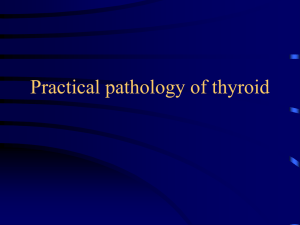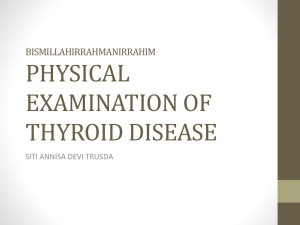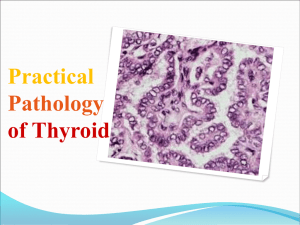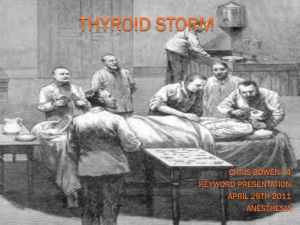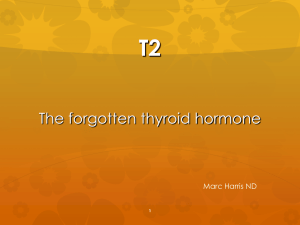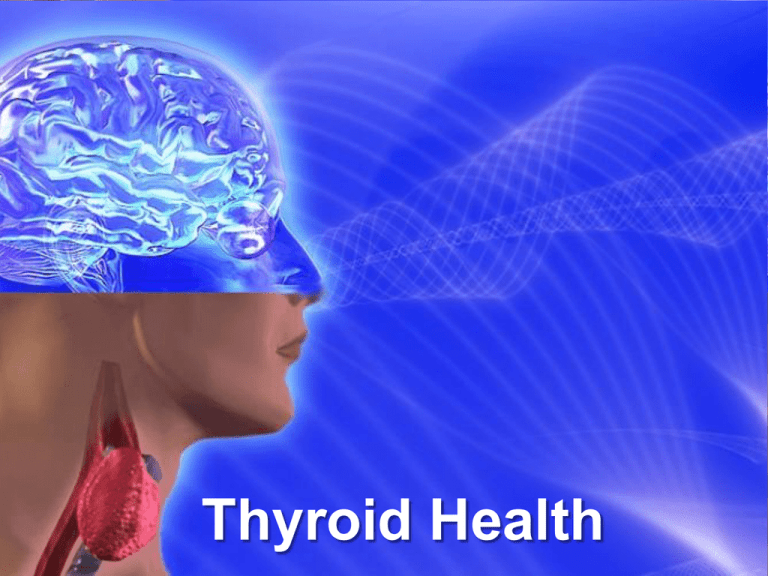
Thyroid Health
Thyroid Health
The Thyroid Gland is a small
gland, normally weighing less
than one ounce, located in the
front of the neck.
It is made up of two halves,
called lobes that lie along the
trachea and are joined together
by a narrow band of thyroid
tissue, known as the isthmus.
Thyroid Health
The function of the thyroid gland is to take iodine, found in
many foods, and convert it into thyroid hormones:
thyroxine (T4) and triiodothyronine (T3)
Thyroid cells are the only cells in the body which can
absorb iodine. These cells combine iodine and the amino
acid tyrosine to make T3 and T4. T3 and T4 are then
released into the blood stream and are transported
throughout the body where they control metabolism
(conversion of oxygen and calories to energy).
Every cell in the body depends upon thyroid hormones for regulation of their
metabolism. The normal thyroid gland produces about 80% T4 and about 20% T3,
however, T3 possesses about four times the hormone "strength" as T4.
The numbers refer to the amount of atoms of iodine contained in the hormones, but
T4 is mostly converted to T3 in the liver and kidneys.
A delicate Feedback Mechanism
When the gland is healthy, it releases as much thyroid
hormone as we need to keep our metabolism on an even
keel. It knows just how much to release because of the
feedback mechanisms between the pituitary and
hypothalamus.
The pituitary contains special cells that are very sensitive
to levels of thyroid hormone in the blood. If they are too
low, it secretes a hormone called Thyrotropin stimulating
hormone (TSH). This in turn stimulates the thyroid to
produce more thyroid hormone.
The hypothalamus has a hand in this too. It can stimulate
or suppress TSH production from the pituitary, by means
of a hormone released from the hypothalamus in response
to environmental changes from the brain, called thyroid
releasing hormone (TRH).
The whole system is sometimes called the 'hypothalamic pituitary -thyroid axis'.
The Effect of T3 and T4
• Increase the basal metabolic rate of almost
all the cells in the body.
• Increase the fat and carbohydrate
metabolism.
• Boost protein synthesis.
• Increase heart rate and blood flow to other
organs.
Thyroid hormones are also needed for normal development of organs
such as the heart and the brain in children and for normal reproductive
functioning.
The thyroid gland also contains the Parathyroid Glands that are
important in bone and calcium metabolism.
Thyroid Problems
1. Underactive thyroid (hypothyroidism) symptoms may include feel sluggish and
tired, gain weight easily, get cold easily, dry
and brittle skin hair & nails, depressed mood,
slower thinking, muscle pain, constipation,
muscle aches, heavier or longer menstrual
periods
2. Overactive thyroid (hyperthyroidism) - feel
jittery, lose weight unintentionally, get hot
easily, rapid heart beat, muscle weakness,
frequent bowel movements, hair loss, shorter
or lighter menstrual periods
3. Thyroid Nodules - one or more lumps in the
thyroid gland. These are usually benign but
may be cancerous so they need to be
evaluated. A history of radiation or family
history of thyroid disease may be present.
4. Thyroid Enlargement (goiter) - See or feel a
swelling in the neck, tighter collars or
necklaces, trouble swallowing or even trouble
breathing
Thyroid Problems
First hyperthyroidism, which sped up my
metabolism and left me unable to sleep for days -most people lose weight. I didn't," Winfrey wrote
in O Magazine. "Then hypothyroidism, which
slowed down my metabolism and made me want
to sleep all the time."
Dr. Samara Ginzburg of the Albert Einstein College
of Medicine in New York said that although
Winfrey has not officially revealed her exact
diagnosis, it sounds like chronic autoimmune
thyroiditis or Hashimoto's disease.
"Hashimoto's can start with a hyperthyroid phase,
due to release of stored hormone from an inflamed
gland, followed by a hypothyroid phase," Ginzburg
said in a statement.
Hyperthyroidism
Hyperthyroidism is when the thyroid becomes overactive
and releases too much T3 and T4 into the blood. Another
name for it is thyrotoxicosis. A person with too much
circulating thyroid hormone finds they are living with a
metabolism that is continually 'revved up'. That person
notices:
•weight loss, despite an increased appetite
•nervousness, agitation and anxiety
•tiredness
•rapid pulse
•tremor (shaking) of the hands
•sweating and sensitivity to heat
•diarrhea
The most common cause of thyrotoxicosis is a condition called Graves' disease, a form of
thyroiditis, or inflammation of the thyroid.
In the case of Graves' disease the attacking antibodies have the effect of stimulating the
thyroid to make excessive amounts of thyroid hormone.
Graves' disease usually begins in the 30s or later. It's nine times more common in women
than men, and it often occurs with other autoimmune diseases.
Hypothyroidism
Hypothyroidism is the opposite condition. In
hypothyroidism, the thyroid fails to make and
release enough T3 and T4 into the bloodstream
and the metabolism slows to a crawl. This
produces a range of physical and emotional
changes, including:
•lethargy and tiredness
•feeling cold (even on warm days)
•difficulty concentrating
•unusual weight gain
•depression
•puffiness of the face
•hair loss
•dry skin
•constipation
Hypothyroidism
Hypothyroidism can happen because the
thyroid itself fails. This is called primary
hypothyroidism, it is more common in women
than men, and usually starts between the ages
of 30 and 50.
Or it can happen when the thyroid is normal
but the pituitary or hypothalamus fail to secrete
enough hormone to keep the 'hypothalamicpituitary-thyroid-axis' working adequately. This
is called secondary hypothyroidism.
Hypothyroidism can also be caused by a lack
of iodine in the diet, which prevents the thyroid
from making enough hormone, or as a side
effect of certain drugs, like lithium.
On a worldwide basis iodine deficiency is the
commonest cause of hypothyroidism.
Natural or Synthetic
From the early 1900s until the 1950s, the only form of
thyroid replacement drug available was natural,
desiccated thyroid, namely, Armour Thyroid.
The drug fell out of favor with some endocrinologists,
as Synthroid's extensive marketing sold synthetic
thyroid as a better, more modern option for thyroid
treatment in the second half of the 20th century.
Since the 1990s, Armour Thyroid has been enjoying a
resurgence in popularity.
Derived from the desiccated thyroid gland of pigs, the
drug contains natural forms of numerous thyroid
hormones and nutrients typically found in a real thyroid
gland.
Thyroid Temperature Syndrome
Look around you at everything that's not plugged in or alive.
Most of the items you see have one thing in common...They're
room temperature. If you died you'd be on your way to room
temperature too. But you're not room temperature!
Whether in the hot Arizona desert, in Alaska, in a freezer, or in a
sauna, our bodies all fight to maintain the same temperature.
They wouldn't do that if it weren't critically important. In fact the
one human characteristic that is most similar across every race,
gender, age, or creed is body temperature. We are all similar.
Thyroid Temperature Syndrome
If you're sitting in a room that's 75 degrees
F, your temperature is probably about 23
degrees higher. Not 5 degrees, not 10
degrees, not 20 degrees or even 25, but 23
degrees! That's no accident.
Some people (even doctors) may say to you
that it doesn't matter if your temperature's a
little low.
Of course it matters! Why else would body
temperature be measured in tenths of a
degree? Why would our bodies struggle to
maintain such similar temperatures?
Thyroid Temperature Syndrome
If your temperature goes too
high you're dead; if it goes too
low, you're dead; if it goes a
little too high, you're going to
feel sick; if it goes a little too
low, you're going to feel sick. I
think that's obvious.
What's considered a low
temperature? Symptoms can
result when the average body
temperature is any less than
98.6 F, measured orally, but the
more classic symptom complex
is seen with an average body
temperature below 97.8 F.
Thyroid Temperature Test
This test is an excellent way to determine thyroid function using basal body
temperature (the body's temperature at rest). If the thyroid is running low, the body's
temperature will drop below normal while the body is at rest-sleep. This test is done
by measuring the underarm temperature upon waking after a night's sleep. For
accuracy, the test is performed five mornings in a row and then the average is
calculated. The instructions for performing the test are as follows:
•The night before, shake down the thermometer (an oral glass thermometer
only), and set it on the nightstand next to the bed.
•Immediately upon waking, without raising your head from the pillow, place the
thermometer under the arm.
•Leave thermometer under arm for 10 minutes.
•Move as little as possible in this process; you must remain flat on your back
during this entire time otherwise the thyroid gland will be activated and a false
reading will be taken.
•After ten minutes, remove the thermometer and record temperature.
•The test is invalidated if you expend any energy before recording the
temperature, i.e., getting up for any reason, shaking the thermometer, etc.
Test Results
Date
Temperature
Day 1
Day 2
Day 3
Day 4
Day 5
To figure average --> Total____________ divided by 5 = __________
An average temperature of between 97.8 and 98.2 degrees is
considered normal.
Hypothyroidism/Hyperthyroidism?
DID YOU KNOW ?
Almost every symptom often assumed to be related to menopause including weight gain, fatigue, moodiness and loss of sex drive-- are
symptoms of an underactive Thyroid.
One in five women has a Thyroid condition by the time she's 60 -but most aren't diagnosed.
An estimated 50 million people have a thyroid dysfunction -- and
most are not diagnosed.
Iodine Supplementation
Iodine is a basic element, as are calcium, zinc,
oxygen and other elements. The word "iodine"
usually refers to two iodine molecules chemically
"stuck together" I2, just as the word "oxygen" usually
refers to two oxygen molecules "stuck together" 02.
Since iodine is more reactive, and therefore more
likely to cause problems, iodine is usually used as
"iodide", a word which refers to one iodine molecule
combined with another molecule such as potassium
k1 or sodium na1.
In chemical terms, such molecules are called "salts";
the best known salt is sodium chloride NaCl, a salt of
chloride Cl2
"Lugol's solution", invented by Dr. Lugol of Paris in
the 1840's, which contains a mixture of types of
iodine and iodide, but prepared as a solid in a
capsule instead of a liquid.
How much Iodine?
Hypothyroid Questionnaire
Hypothyroid Questionnaire
Salt: What Kind and How Much
To find the amount of salt you need, gradually
increase your salt intake until you find the amount
you feel best on -- usually 2 to 10 grams or roughly
1/2 to 1 tablespoonful. After determining the amount,
try to cut back and see if that is just as effective.
Table salt is NaCl sodium chloride, which causes an
imbalance in the electrolyte system in the body.
Sea salt is a complete salt with a balance of minerals
(electrolytes) as found in nature.
Celtic Sea Salt is truly a whole sea salt highly
recommended by health care professionals and
culinary chefs. Celtic Sea Salt provides your body
with over 80 minerals while enriching the flavor of all
foods. Third party Certified by Europe's Nature and
Progress to be free from pesticides, herbicides, and
harmful chemicals.
Meat and Potatoes
Supplement Iodine with: ADD, ADHD, Asthma, Fibrocystic breast
Iodine Triggers apoptosis (programmed cell death)
Every 17 minutes all the blood passes through the Thyroid.
Thyroid 6 mg, Breast 5 mg, other tissues 2 mg = 13 mg a day
3" X 3" square patch on forearm and cover with a bandage, should look the same after 8 hours.
Stops iodine absorption: Bromine in bread, Fluoride in toothpaste and water and Chlorine
Aflatoxin in peanuts will shut down the thyroid
70% of serotonin is made in the gut
Acid reflux: Cardiac valve shuts tight at a pH of 2 (HCl deficiency)
Reflux: 2 teaspoons of apple cider vinegar or lemon and water
Gallbladder: beet leaf thins bile
Appendix: Stores your unique bacteria
Constipation: Iodine and collinsonia root
Meat and Potatoes
Hormones are made from: Amino Acids, Minerals and Cholesterol
Canola oil: Made from Rape seeds in Canada
LDL is not cholesterol, it caries cholesterol to the thyroid. Low LDL = low thyroid
1911: vegetable oil and processed food were introduced into the American diet.
1926: First case of heart disease reported
Best oil Coconut (difference between oil and a fat)
Olive oil: Buy in a can or dark bottle only
To decrease Cholesterol go on a high cholesterol diet (butter and heavy whipping cream)
Cholesterol is the #1 antioxidant in the body: used for healing
Sugar causes every disease known to man: A high sugar meal can suppress the immune system
for up to 6 hours.
Soy was imported into the U.S. in the 1930s to make tires
A can of soy protein is equal to 6 birth control pills
Meat and Potatoes
People with a cholesterol over 300 live the longest (over 100 years old)
Wake up before 3:00 am Cortisol high, after 3:00am liver
Toxins love to go to inflamed area because of low pH
American spirit cigarettes: most natural
1922 10#----1970 120#----1994 150#---1997 160# = 1/2 # per day
Every spoonful you eat is an act of nourishment or an act of assisted suicide
It is not always bad germs, bad luck or bad genes: In many instance it is just unhealthy choices
Fat-soluble compounds leave the lymph and enter the blood circulation at the thoracic duct
WITHOUT passing through the liver first. Fat goes to the heart first. The heart uses fat for fuel.
A F Betafood for liver and bile flow: 5- 3X a day for 30 days
Meat and Potatoes
Ear infections: Immuplex
Chest colds: Congaplex
Give your patients clarity: it will empower them: A confused patient is paralyzed
FEAR = False Environment that Appears Real
Thyroid and Adrenal medical treatment: WAG method
Your patients would like to: Eat junk, not exercise, sleep 12 hours a day and not work
If I had 8 hours to chop down a tree, I would spend 6 hours sharpening my AXE. (LINCOLN)
A diet that will work 100% of the time: Cocaine and heroine--- You will be skinny but you will not be
healthy.
Body weight divided by 2.2 = X
2 oz of meat or chicken = 15gm
3 oz of fish = 15 gm
1 egg = 7 gm
X times .8 = Grams of protein needed per day.





